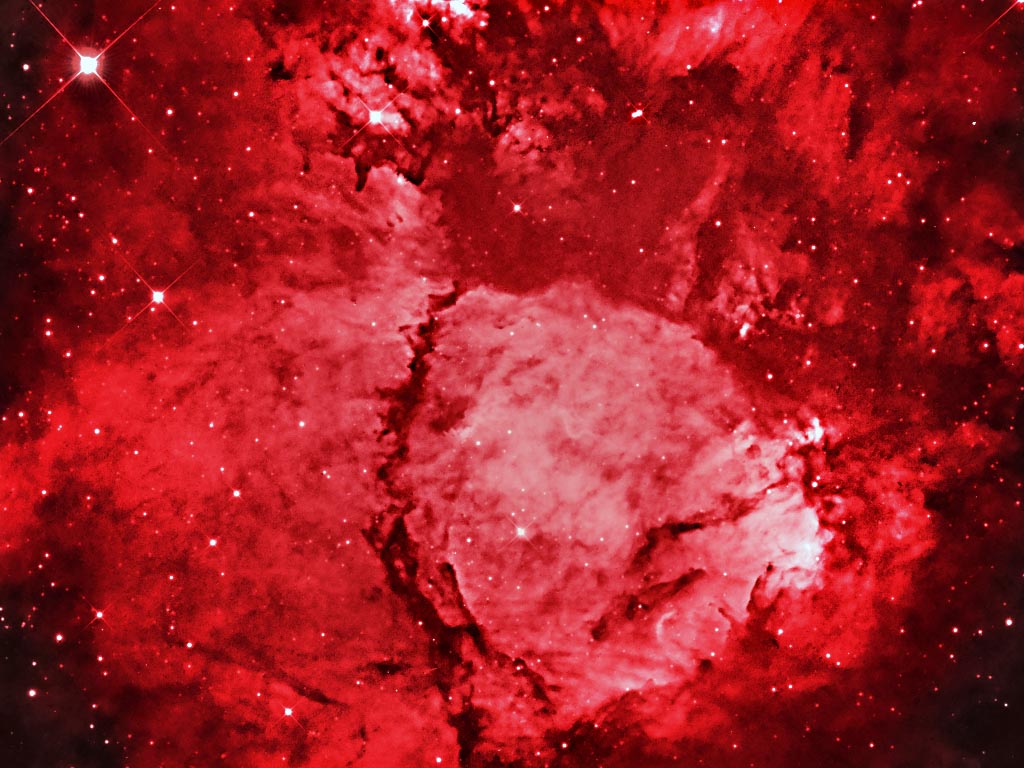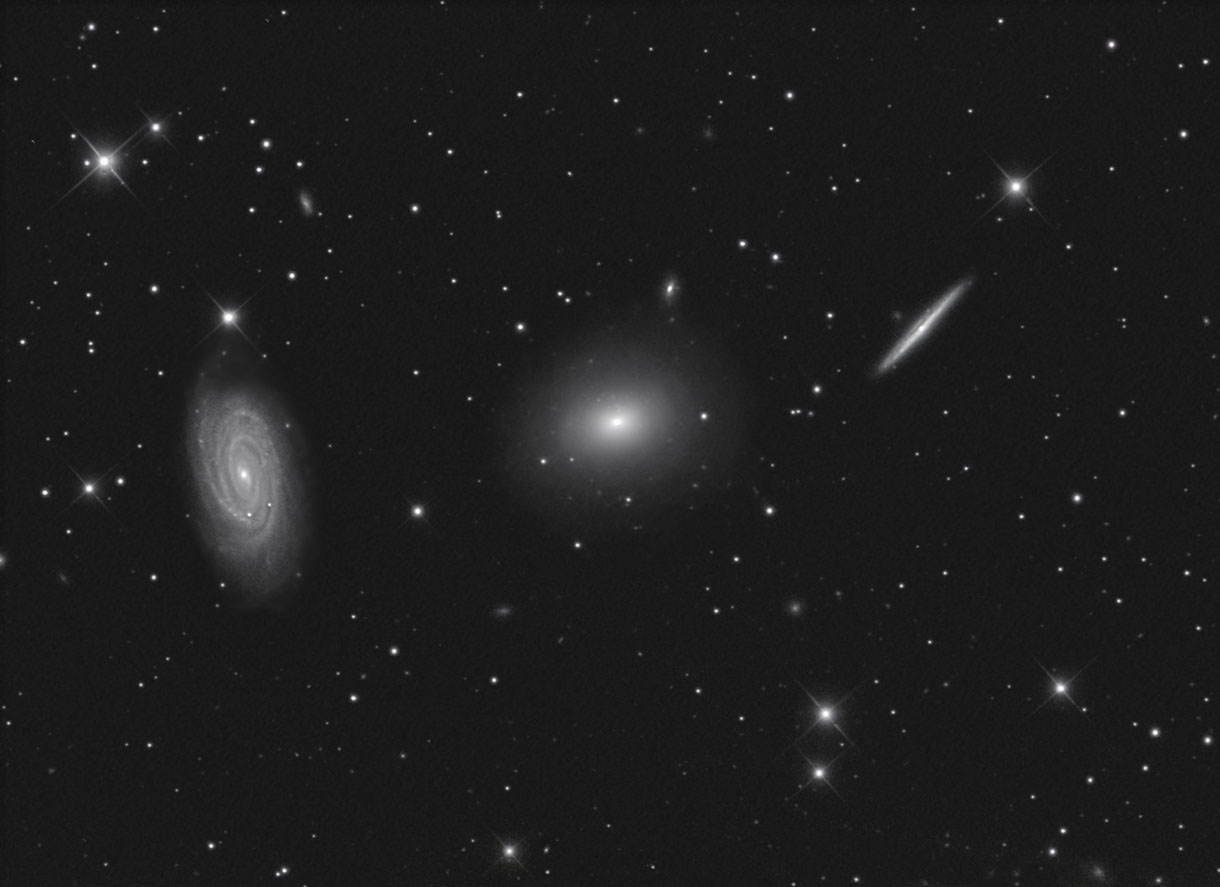ARCHIVE 2009INTRODUCTIONImaging from the worst place on Earth? Possibly! Welcome to my image blog from Lancashire, UK. Living in Lancashire does make imaging a challenge. Our incessant damp cloudy weather is legendary and coupled with light pollution probably as bright as can be found anywhere (I am 15 miles NW of the centre of Manchester) makes for testing times! Add to that flight path one with constant aeroplanes, which is why it has been suggested as possibly the worst place on Earth for imaging. Now the good news. With modern light pollution filters we can still produce excellent results - at least when the clouds clear - but of course we cannot match dark sites - I avoid looking at images from such sites as they are very depressing and un-representative of what the rest of us have to suffer! So if you too live in cloudy suburbia then I hope the following images offer some encouragement. I often shoot the luminance and the colour simultaneously - there are not enough clear spells to alow the luxury of shooting separately. Having two telescopes and two cameras is obviously essential for this - as is having a dome slot wide enough for both to have a clear line of sight. The luminance is usually taken with the RCOS + Apogee Alta and the colour Takahashi + Canon 40D. Despite their disparate focal lengths this works reasonably well as the Canon has 5 micron pixels (plate scale 2 arcsecs/pixel) and the Apogee 18 micron ones when binned 2x2 (plate scale 1.3 arcsecs/pixel). I find binning essential to maximise signal and improve the signal-to-noise ratio. The images are all taken from my back garden and appear in order of me processing them - we have plenty of cloudy nights for that. I use a combination of IRIS and Maxim for processing with final tweaks in Photoshop CS2. To get rid of the light pollution takes much trial and error. IRIS scores here with several options but processing often comprises many nights work - certainly always longer than the actual taking. The exception are images taken with an h-alpha filter which is a superb light pollution filter. It also permits imaging with strong Moonlight present - isn't it funny how it always seems to be clear at full Moon! |
DECEMBER 18th, 2009Edge-on Spiral Galaxy, NGC1560 Located in Camelopardalis. Clouded out so no colour information - yet. Image details:
|
NGC1560 |
DECEMBER 14th, 2009Cheshire Cat or Smiley Face Asterism Binoculars show a curved arc of stars (the mouth) plus 2 more above them (the eyes) just south-west of the open cluster M38. One the best asterisms for binoculars Image details:
|
| Cheshire Cat
|
DECEMBER 5th, 2009Emission Nebula IC1795 IC 1795 is a prominent emission nebul;a in Cassiopeia. It is also known as NGC 896 and is an outer part of the very large Sharpless Sh2-190. Image details:
|
 |
IC1975 |
DECEMBER 12th, 2009Spiral Galaxy, M74 Located in Pisces. Probably the faintest Messier object - certainly the most difficult visually for me. Image details:
|
M74 |
OCTOBER16th, 2009Stephan's Quintet, NGC 7331 Located in Pegasusclose to NGC 7331. Not really a quintet as one galaxy is a foreground object and the remaining 4 in the background. Colour information was taken but this is one object I think is better in mono. Image details:
|
Stephan's Quintet |
OCTOBER11th, 2009Spiral Galaxy, NGC 7331 Located in Pegasus. The four small galxies to the east (left) are background objects and not associated with NGC 7331. Image details:
|
NGC7331 |
OCTOBER 8th, 2009The Bubble Nebula, NGC7635 Located in Cassiopeia this object features also in a famous Hubble image. Image details:
|
Bubble Nebula |
SEPTEMBER 20th, 2009Fomalhaut from Kelling Heath How low can you go! Fomalhaut appearing above the trees at the Kelling Heath Star Pary 2009. Image details:
|
Fomalhaut |
SEPTEMBER 10th, 2009The Cocoon Nebula, NGC5907 Located in Cygnus, this nebula has it all being in part an emission nebula, a reflection nebula and a dark nebula. Quite a combination! Image details:
|
Cocoon Nebula |
AUGUST 24th, 2009Pickering's Triangle, NGC6979 Central part of the Veil nebula Image details:
|
Pickering's Triangle |
AUGUST 21st, 2009Tower in the Pelican, IC5067 Not the tower of creation but the similar one in the Pelican Nebula. Image details:
|
IC 5907 |
MAY 21st, 2009Draco Trio, NGC5981, 5982 & 5985 NGC 5982 and 5985 (middle and left) seem to be an associated pair at around 133 million light years whereas NGC 5981 (right) appears to be somewhat nearer at 100 million light years. Image details:
|
 |
NGC 5985 |
APRIL 29th, 2009Classic Edge-on Spiral Galaxy, NGC5907 Located in DRACO, this edge-on galaxy has no prominent central bulge so is probably a Sc or Sd type. Image details:
|
NGC 5907 |
APRIL 20th, 2009Keenan's System, NGC5216 & 5218 (Arp 104) Located in Ursa Major, these interacting galaxies have formed a bridge between them. Image details:
|
Keenan's System |
APRIL 18th, 2009Classic Edge-on Spiral Galaxy, NGC4565 Located in Coma Berenices. The galaxy is slightly warped - note dust lanes crossing. Image details:
|
NGC 4565 |
MARCH 29th, 2009The Owl Nebula, M97 Planetary nebula located in Ursa Major. Image details:
|
M97 |
MARCH 20th, 2009Edge-on Spiral Galaxy, M108 Located in Ursa Major. Image details:
|
M108 |
MARCH 5th, 2009Spiral Galaxy, M81 with Holmberg IX Located in Ursa Major. Holmberg IX is the dwarf galaxy to the east (left) of M81. Image details:
|
M81 |
FEBRUARY 26th, 2009Irregular Galaxy, M82 Located in Ursa Major about 12 million light-years away. M82 is the prototype starburst galaxy. The starburst activity is five times as bright as the whole Milky Way and was probably caused by a recent close encounter with M81. This galaxy responds well to imaging with an H-aplha filter revealing the gas being ejected from the galaxies active centre. Image details:
|
M82 |
FEBRUARY 11th, 2009Rosette Nebula, NGC2237 Close-up of the northern part of the Nebula. Image details:
|
Rosette Nebula |
JANUARY 26th, 2009Cone Nebula, NGC2264 Located in Monoceros. A Ha filter was needed to pull this nebula out of the light pollution. Image details:
|
Cone Nebula |
|
Please remember these images are copyright David Ratledge. Contact me before any use is made of them. |